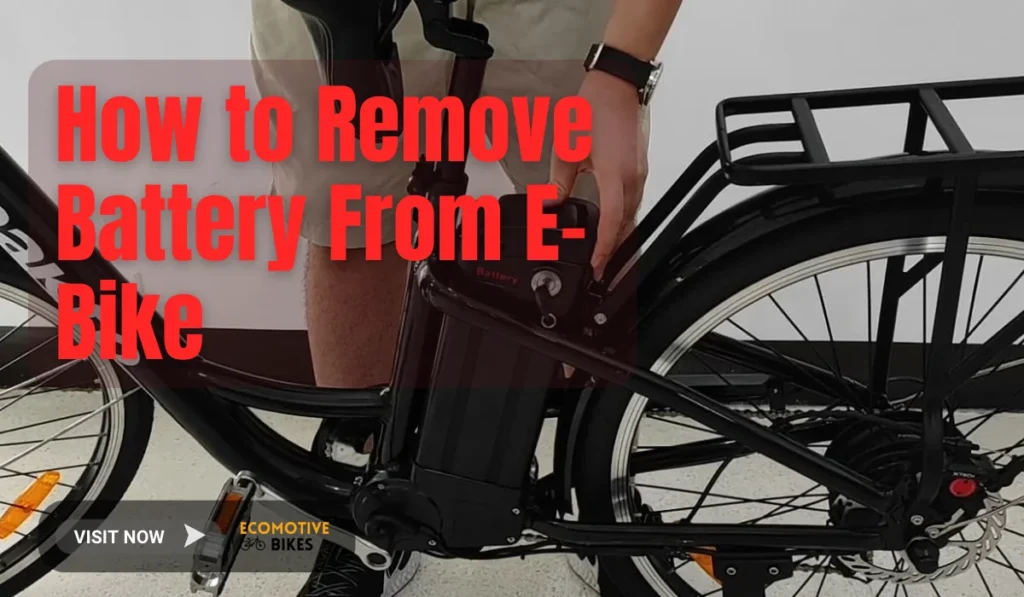How to Remove E-bike Battery Easily and Safely? 6 Easy Steps
Need to pop out your e-bike battery for a charge or some quick maintenance? Don’t sweat it, for removing an e-bike battery is a breeze once you know these simple steps. So, whether your trusty steed has a sleek, integrated design or a classic, removable pack, this guide will show you exactly how to remove…
Table of Contents
Related Articles:
Need to pop out your e-bike battery for a charge or some quick maintenance? Don’t sweat it, for removing an e-bike battery is a breeze once you know these simple steps.
So, whether your trusty steed has a sleek, integrated design or a classic, removable pack, this guide will show you exactly how to remove your e-bike battery safely and in no time. So, ditch the confusion and get ready to unlock the battery!
When to remove the e-bike battery?
Before we jump into the removal process, let’s explore why you might need to detach your trusty e-bike battery. There are several key scenarios:
- Convenient charging: E-bike battery range may not always match your riding plans. Removing the battery allows for convenient indoor charging, ensuring your e-bike is fully powered and ready for your next journey.
- Enhanced security: E-bike theft is a concern. Detaching the battery acts as a potential deterrent, particularly for opportunistic thieves who may be discouraged by the extra step involved.
- Simplified transport: When space is limited during transportation, removing the battery can significantly reduce the overall weight of your e-bike, making it load.

How to remove e-bike battery? Step-by-step guide
For optimal safety and efficiency, follow these steps when removing your e-bike battery:
Step 1: Power down for safety: Safety first! Always ensure your e-bike is completely switched off before attempting to remove the battery. Additionally, disconnect any electrical accessories to avoid accidental shorts.
Step 2: Immobilize the e-bike: For added stability and to prevent accidental movement during removal, firmly engage the brakes on your e-bike. Alternatively, use a bike stand to create a secure and stable base.
Step 3: Key management: Some e-bikes utilize a locking key for battery security. If yours does, remove the key. For keyless models, consult your manufacturer’s instructions for the specific unlocking procedure.
Step 4: Electrical disconnection: Before physically removing the battery, disconnect all electrical connections. These typically involve cables linking the battery to the motor and control system. Handle these connections gently to avoid damage. Here’s how:
- Locate the connection point: Identify the area where the battery connects to the bike. This will typically involve a set of wires bundled together and secured by a connector.
- Prioritize connector handling: For a smooth and secure detachment, always grip the connector itself, not the wires, when unplugging it. This minimizes stress on the wires and prevents potential damage.
- Unlock connectors (if applicable): Some connectors might have a locking mechanism for added security. If you encounter one, carefully disengage the lock using your thumb or a small tool, following the manufacturer’s instructions (if provided) to avoid any forced manipulation.
Step 5: Tool requirements: Depending on your e-bike model, you might need specific tools like a spanner or screwdriver to unlock or unfasten the battery. Refer to your user manual for details on any required tools.
Step 6: Battery detachment: The removal process itself varies depending on your battery location.
- Under-rack battery: If your battery sits under the luggage rack, unlock it (if applicable) and then slide it backward for removal.
- Frame-mounted battery: For batteries positioned on the frame, unlock it (if applicable) and then carefully tip it to the side or rear to unclip it from its holding cradle. Always prioritize care to prevent damage to the electrical connections during this step.
Safety precautions for e-bike removal
For a safe e-bike experience, remember to prioritize these steps:
- Power down: Always turn off your e-bike completely to prevent electrical shocks.
- Unlock the battery: If your e-bike uses a key, make sure the battery is unlocked before attempting to remove it.
- Protect your hands: Wear gloves when handling the battery. This safeguards against sharp edges or potential contact with corrosive materials.
- Warranty check: Improper battery removal can void your warranty. Review the terms to ensure you’re handling it correctly.
How to maximize your r-bike’s performance?
Here are the three tips to ensure the optimal performance of your e-bike.
- Proactive monitoring: Regularly monitor your e-bike battery’s charge level, even when the battery remains in the bike. This proactive approach helps ensure maximum range for your journeys and avoids the inconvenience of a depleted battery mid-ride.
- Maintain optimal power transfer: When removing the battery for charging or storage, take the opportunity to clean the connection points with a dry, lint-free cloth. Clean connections are essential for optimal power transfer between the battery and the e-bike’s electrical system.
- Manufacturer-specific recommendations: E-bike models may have slight variations in battery care requirements. For the most up-to-date and specific guidance, consult your owner’s manual to ensure you’re following the manufacturer’s recommended practices for optimal battery performance and longevity.
Frequently asked questions on e-bike battery
Can I remove an e-bike battery without the key?
No, as most e-bike batteries are equipped with a locking mechanism that requires a key for removal. This is a security measure to prevent theft. If you’ve lost your key, it’s crucial to contact the e-bike manufacturer or a professional for assistance to avoid damaging the locking mechanism during removal.
Does pedaling an e-bike charge the battery?
No, pedaling an e-bike generally doesn’t charge the battery. Most e-bikes rely on external power sources for charging.
However, some advanced models might have regenerative braking systems that can provide a slight charge to the battery when riding downhill or braking. This feature won’t fully recharge the battery, but it can offer some additional range in specific situations.
How do I know if my e-bike battery needs replacing?
There are a few signs that indicate your e-bike battery might be nearing the end of its lifespan:
Reduced range: You experience a significant decrease in the distance you can travel on a single full charge compared to when the battery was new.
Extended charging time: The battery takes noticeably longer to charge to full capacity.
Poor charge retention: The battery doesn’t hold a charge as well as it used to, draining more quickly during use.
Physical damage: You observe visible signs of damage on the battery casing, such as swelling or cracks.
If you experience any of these issues, it’s recommended to consider replacing your e-bike battery.
How to store an unused e-bike battery?
When your e-bike battery isn’t in use, proper storage is essential for maintaining its health and longevity. Here are some key storage tips:
Cool and dry place: Store the battery in a cool, dry place with moderate temperatures. Avoid extreme heat or cold.
Partial charge: It’s ideal to store the battery with a partial charge, between 40% and 80% capacity.
Long-term storage: If storing the battery for an extended period (months), check on it periodically and top up the charge if it falls below 40%.
How should I protect my e-bike battery during transport?
Safeguarding your e-bike battery during transport is crucial. Here’s what you should do:
Padded case: Utilize a padded case specifically designed for e-bike batteries. This padding offers essential protection against bumps and jolts that could damage the battery during transport.
Secure placement: If a padded case isn’t available, ensure the battery is securely fastened in place within your vehicle or transport container. This prevents the battery from moving around and potentially sustaining damage from impacts.
How can I ensure the safety of the battery terminals during transport?
Protecting the battery terminals is vital to prevent electrical hazards. Here’s how to ensure safety:
Non-conductive cover: Cover the battery terminals with non-conductive material, such as tape or plastic. This prevents any potential short circuits that could occur if the terminals come into contact with each other or conductive objects during transport.
Final Word: How to remove e-bike battery?
With the power down, battery unlocked, hands protected, and these simple steps you’re now ready to tackle that e-bike battery! Make sure to follow the manufacturer’s instructions to ensure optimal maintenance. So, now, go forth and explore with confidence!





